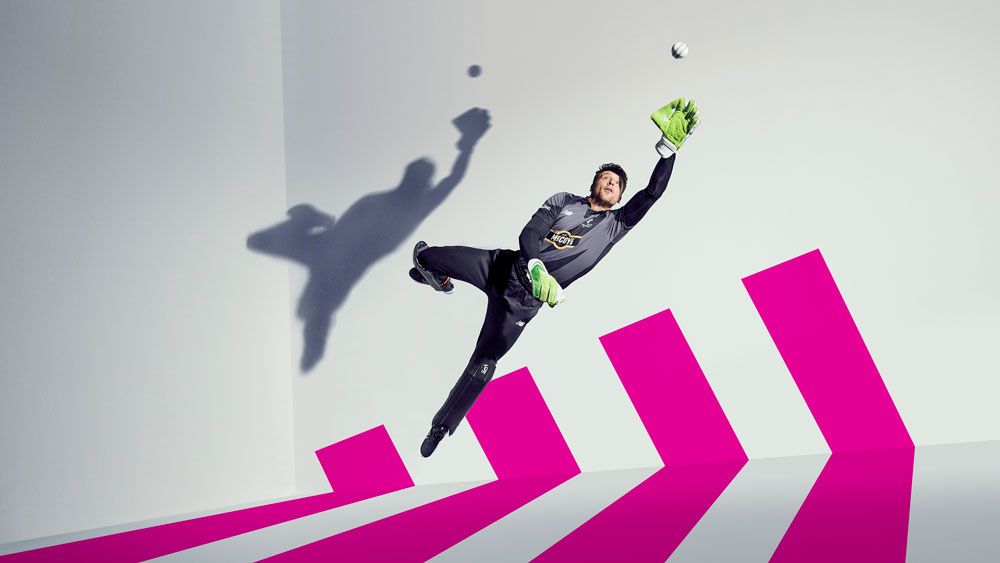How Cricketer Jos Buttler Trains For Power In The Gym
As the launch of the new format The Hundred approaches, we quizzed the England wicketkeeper about his strength and conditioning work

Five-day test matches may give the casual observer the impression that cricket is more a marathon than a sprint, but it’s more accurate to call it a marathon of repeated sprints. “Even though cricket is a long game, the elements of it are fast and explosive,” says Jos Buttler, vice-captain of England’s one-day and T20 teams, speaking to Coach before he begins playing for the Manchester Originals – one of eight teams in the new limited-overs cricket format, The Hundred.
“The Hundred is going to be all-action,” says Buttler, who will be able to put his power hitting to good use once the competition begins on 21st July. We quizzed Buttler on how he trains in the gym and what he thinks amateurs should add to their training to improve their game. We also have an example workout from Buttler’s training programme, courtesy of England's national lead strength and conditioning coach Rob Ahmun.
Unfortunately, the workout does not include what Buttler described as his favourite exercise for developing batting power, we assume for reasons of health and safety, or at least gym etiquette: repeatedly smashing a cricket bat into a punch bag.
How important is the gym work you do to your performance?
It’s vital. As the game’s become more professional over the years, people have really taken an interest in the strength and conditioning element of the game. We need to be fit and strong and robust, so we can be on the park more often than not.
It’s an explosive sport, so lots of training is geared around that. A lot of those marginal gains that can improve you as a player can be made in the gym.
How has your gym training changed over the course of your career?
There’s more focus on those power elements and speed. There’s a piece of equipment called GymAware which you can connect to, say, the Olympic bar to track the speed of the bar. It’s very precise and a great training aid. As opposed to just trying to lift as heavy as you can, it’s trying to make sure that the bar is moving at the right speed to target the right kind of training.
Also, making sure you get enough rest. A lot of the time, you do a gym session and you want to just get it done as quickly as you can. But actually, it's important to have that rest between the sets to allow you to be working the right energy systems.
Get the Coach Newsletter
Sign up for workout ideas, training advice, reviews of the latest gear and more.
What’s the most effective thing an amateur cricketer could do in the gym?
I’d say those power activities, so squat jumps. For a wicketkeeper like me, working on the way you move laterally. Ice skater movements pushing off on a single leg to be powerful.
Also, work on your sprinting technique. I know a lot of the bowlers work hard on that. Being efficient and conserving energy allows them to perform better.
See related
- A Sports Strength & Conditioning Workout To Build Power, Stamina And Strength
- England Cricket Captain Eoin Morgan On The Most Powerful Way To Lead
- Buddy Up For Owen Farrell’s Strength And Power Workout
Strength And Power Gym Workout For Jos Buttler
This session, designed by Ahmun, is an example of the type of gym session Buttler will perform during The Hundred, maintaining his strength and power outputs during a competitive period.
“A fundamental relationship exists between strength and power,” says Ahmun, “which dictates that you cannot possess a high level of power without first being relatively strong. In other words, you need to get strong before you get powerful.
“When designing power training programmes, the nature of the sporting movements need to be clearly identified so that exercises are related to the sport demands. Ballistic, plyometric and weightlifting exercises can be used effectively as exercises within a power training programme to enhance maximal power.
“Jos’s programme is multidirectional and takes into account exercises to improve power when batting and also running between the wickets.”
Warm-Up
Ahmun recommends using yoga movements to warm the body up for the session and to maintain mobility.
Workout
1A Barbell jump squat Sets 3 Reps 5
1B Cable rotation Sets 3 Reps 5 each side
2A Barbell split squat Sets 3 Reps 4
2B Chin-up Sets 3 Reps 4
3A Medicine ball side wall throw Sets 3 Reps 5 each side
3B Broad jump (for distance) Sets 3 Reps 4

Jonathan Shannon was the editor of the Coach website from 2016 to 2024, developing a wide-ranging experience of health and fitness. Jonathan took up running while editing Coach and used the training plans on the site to run a sub-40min 10K, 1hr 28min half marathon and 3hr 6min marathon. He’s an advocate of cycling to work and is Coach’s e-bike reviewer, and not just because he lives up a bit of a hill. He also reviews fitness trackers and other workout gear.
